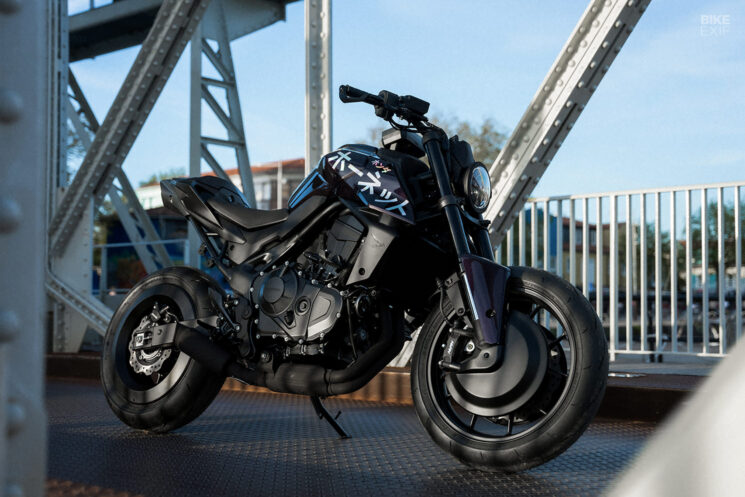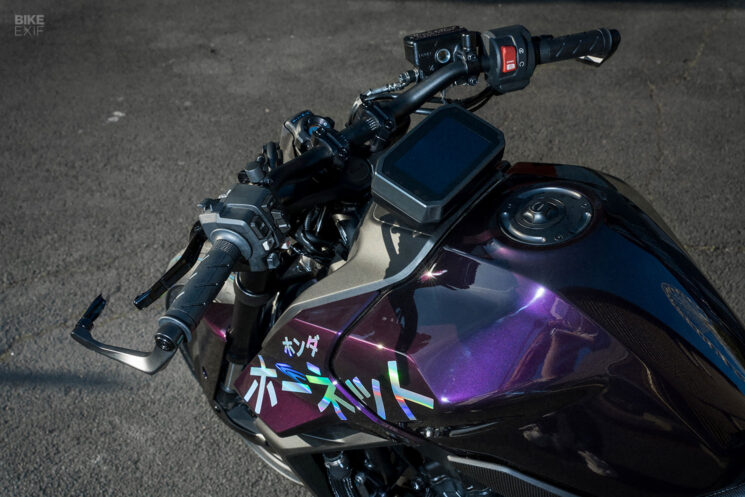
Leading the charge this week is a custom Suzuki SV650 that has no business looking as good as it does, courtesy of Australia’s Purpose Built Moto. In hot pursuit are a carbon-clad Ducati XDiavel, a Manga-inspired Honda CB750 Hornet, and a wild BMW R1250RS drag bike.

Suzuki SV650 by Purpose Built Moto In production since 1999, the Suzuki SV650 is a do-it-all bike that mostly flies under the radar. But that cannot be said for Purpose Built Moto’s latest creation. Tom Gilroy and the Gold Coast-based team have turned the nondescript SV650 into a stunning retro racer.
Tom started by going over their customer’s list of requirements to wrap his head around the brief. “While he didn’t have a completed picture, the list of items on his brief screamed retro racer to me,” he explains. “After a conversation and a few ideas from my end, we got to work on creating a track-worthy Suzuki SV650 retro racer, but with all the modern necessities needed for the street.”

This custom Suzuki SV650’s big drawcard is its beautiful bodywork. Gone are the sharp angles of the early-2000s, with retro fairings from Airtech Streamlining taking their place. The front fairing is mounted on custom brackets that tie it in perfectly with the stock fuel tank.
A KTM headlight-shaped hole was cut out of the fairing, with PBM Hollow-Tip LED indicators taken from the Purpose Built catalog. The windscreen was made by their “windscreen guy” in Sydney and is unique to the build. The new dashboard is also custom; a Daytona digital speedo relays all the necessary info to the rider.

A fiberglass tail section sits on a new subframe, built from scratch to get the angle just right. The custom seat was trimmed by PBM’s usual supplier—Timeless Automotive Trimming.
Tom likes to plan ahead, so the subframe was designed from the get-go to accommodate a high-mounted exhaust system. The headers terminate in a pair of PBM Torpedo mufflers, mounted alongside turn signals and a taillight from PBM’s catalog..

With such track-focussed Suzuki vibes, PBM chose a Barry Sheene Heron Suzuki-inspired paint job. The classic livery (complete with Fabergé logos) looks ravishing laid over the retro bodywork. To complete the build, the engine was upgraded with an MWR airbox, Power Commander ECU, and a tune, care of Dynomite Moto.
With 74 hp at the wheel and weighing just 175 kilos [386 lbs], we’re more than certain this retro racer rides even better than it looks. [More]

Ducati XDiavel by Bad Winners Founded in 2014, the Paris-based custom shop Bad Winners is fast approaching its 10th anniversary. To celebrate, founder Walid Ben Lamine is planning to release a limited run of 20 custom Ducati XDiavels. It’s the second Ducati XDiavel we’ve featured in as many weeks—but this one is the polar opposite of the last one.

For this series, Walid has chosen to focus on lightweight body design, usable performance upgrades, and ergonomics. He’s no stranger to kit-built bikes; he once built a Husqvarna Vitpilen 701 for F1 star Charles Leclerc, which you can now buy in kit form. And he has a particular penchant for carbon fiber bodywork, so that’s approach he’s taken with the Ducati XDiavel.
Sitting up front are a carbon fiber front fender, perched above a twin Beringer front brake setup. A Bad Winners headlight and nacelle sit up top, with custom radiator shrouds and a redesigned belly pan mounted lower down.

There’s more carbon fiber further back, where a custom fuel tank and tail section replace the OEM items. The angular design of the tank carries through to the short flat track-inspired tail, which is cantilevered over the back wheel. The changes continue around the back, where a carbon fiber blank-off plate keeps things tidy and hosts twin vertical taillights.
The cockpit parts are stock, but Walid has installed Ducabike rear-set pegs to improve the riding position. Finished with a leather seat and with the carbon textures fully on display, Bad Winners’ XDiavel looks downright menacing. But there’s even more work under the carbon bits, where a plethora of custom-made mounts and brackets keep everything in place.

Given the amount of carbon fiber here, the weight loss along would be significant. But Walid has gone a step further, by having the ECU reprogrammed to the tune of 178 hp. Hot air exits through a full titanium exhaust from Arrow.
If you can see yourself astride this dark horse, we’re sure Walid will let you choose any color you like (as long as it’s black or carbon). We’ll take the chef’s choice, please. [Bad Winners]

Honda CB750 Hornet by Viba The new Honda CB750 Hornet is a nicely packaged machine. Its 755 cc 270-degree parallel twin engine produces good power, it has decent suspension, its 190 kg [419 lbs] curb weight is promising, and it’s even priced well.
Its only downfall? Aesthetics. It’s decidedly modern and a little bit bland, falling neatly into the category of bikes that look like insects.

This particular Hornet doesn’t suffer from that affliction. It was built by the French custom shop Viba—commissioned by the Nouveau Monde La Rochelle Honda dealership to enter Honda France’s Hornet custom design contest.
The bike was inspired by a character from the Japanese manga Cat’s Eye, written by Tsukasa Hojo. The story of Cat’s Eye shadows the three Kisugi sisters—Hitomi, Rui, and Ai—and their adventures. They are virtuoso art thieves, trying to collect all the works belonging to their missing father.

Inspired by the agile and fearless eldest sister, Rui (or Sylia in some translations), Viba turned the Hornet into what they thought she would ride.
“Cat’s Eye left an impression on me when I was a teenager, probably because they are strong women, much like the muses that inspire our creations,” says Viba’s designer, Yann. “In the manga, the three sisters ride motorcycles—Hondas to be precise. I had that in mind for a while. When my friend Michel told me about the contest, it was a no-brainer.”

Viba specializes in 3D printing, so they played to their strengths on this job. The bike’s insectile headlight was replaced with a much more subtle round LED unit, as a nod to the original Honda Hornet. The rest of the cockpit was similarly overhauled, with the dashboard now sitting on top of the tank in a new 3D-printed housing. The front fender was redesigned to follow the lines of the Hornet’s tank covers, with 3D-printed MotoGP-inspired brake disc covers mounted on either side.
The rear wheel now sports an “aero wheel” cover, which Viba designed to give the back end more visual mass. The tail section sports a custom cowling that replaces the passenger seat, and a 3D-printed taillight housing with three vertical LEDs, paying homage to the three sisters.

Then there’s the Honda Hornet’s alluring new paint job. Viba picked an aubergine purple hue, in honor of the color that Rui/Sylia often wore. It appears black in some lighting, but shift the bike into the sun and it pops like crazy. Holographic lettering on the tank (spelling Honda Hornet in Japanese Katakana) adds to the Manga vibe.
Incredibly, once the bike was designed it was sourced and built in just five weeks. It’s a testament to Viba’s design acumen, skill, and experience in the area of 3D printing. As far as a heist escape vehicle goes, we can’t think of a better one. [Viba | Images by Victor Sellier]

BMW R1250RS by Kraftstoffschmiede and Man and The Machines The Sultans of Sprint drag racing series produced some of the best-looking custom bikes we’ve ever seen. That’s because points weren’t just awarded for winning races, but also for style. So over all the classes that took to the 1/8th-mile drag strip, we got everything from mild to unquestionably wild.
This BMW R1250RS falls into the latter category. We’ve technically featured it, and its predecessor, before. Dubbed ‘Hercules II,’ it’s the evolution of the bike that Phil Ludwig (Kraftstoffschmiede) and Kris Szews (Man and The Machines) keep racing, rebuilding, and refining.

The Sultans of Sprint series ended in 2019, but thanks to Phil and Kris, the incredible machines designed and built for the series have found a new home. The boys started Rocket Race Club in 2022, picking up right where Sultans of Sprint left off. Hercules II took the top step of the podium in the first year of Rocket Race Club, but Phil and Kris weren’t going to rest on their laurels.
For 2023, Hercules II was optimized to compete in the Brand Bash class. The new class includes more modern bikes, with liquid cooling and no limit on engine displacement. Phil spent hours in the dyno room, with Hercules II pumping out 160 hp and a whopping 200 Nm of torque, thanks to the NOS tank slung beneath the seat.

The bike also uses the shorter-ration transmission from a BMW R1250GS, and the suspension is slammed to the moon; perfect for drag racing. Hattech supplied the custom twin exhaust, which snakes around the bottom of the bike and over the top of the swingarm.
But the main upgrade on this iteration of the build is Hercules II’s new bodywork and BMW M-inspired livery. A small fuel cell sits low in the customized frame, which is draped in a carbon monocoque body. The carbon fiber was laid-up in a custom mold that Phil and Kris milled out—so they can build more of these if they want to.

After his victory at the end of the 2023 Rocket Race series, Phil now has back-to-back wins in the Brand Bash class. Can the team keep up its winning streak? Regardless, we’re excited to see how Hercules III turns out. [Source | Images by Uwe Fischer]
